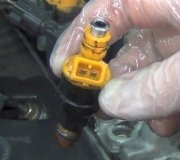You still have something going on that is causing there to be no change when you crank the engine. The glaring clue is your often-overlooked observation that the engine will stay running, (poorly), as long as the accelerator pedal is moving. The Engine Computer still doesn't know where to start its fuel metering calculations. It just knows it needs more, based on the direction and speed of travel of the throttle.
A wiring problem will also cause no change in map reading but that would set a different fault code. If you have access to a scanner, use that to view live data and see what the map reading is doing. It typically starts out at around 4.4 volts, then drops to around 1.2 volts when the engine is idling. I could see one sensor developing a problem, but since failure now is so rare, to have a new one do the same thing, I'd expect to find a protective cover that didn't get removed before installation, or something weird like that. Be sure the rubber o-rings are in place on the nipple of the sensor.
Did you erase the fault code after the new sensor was installed? Removing the PVC hose can cause such a big vacuum leak that not enough vacuum will build up right after starting to be detected by the map sensor. Those sensors are so sensitive they can detect engine rpm by the pulses as each cylinder takes a gulp of air. We don't actually do that, but it is normally a very tiny change in vacuum it has to see at cranking, and it may not with the PVC hose disconnected.
Once that problem is detected, the Engine Computer "injects" an approximate value to run on based on other sensor readings and operating conditions. As long as that code remains in memory, it may continue to do that even after the new sensor is installed. The computer has to learn the characteristics of the new sensor and it may not do that while the code is still in memory.
SPONSORED LINKS
Was this helpful?
Yes
No
Friday, August 16th, 2019 AT 12:05 PM
(Merged)



